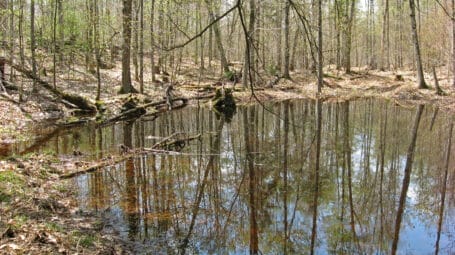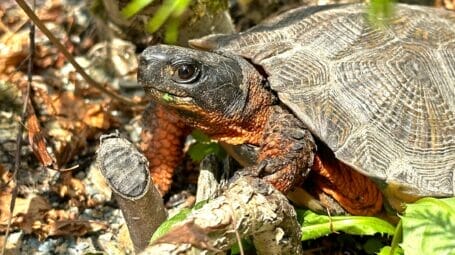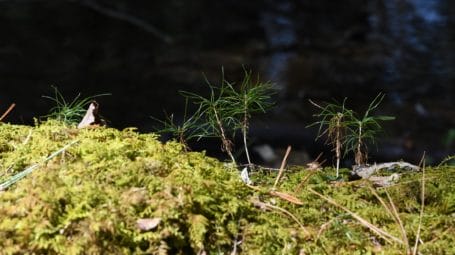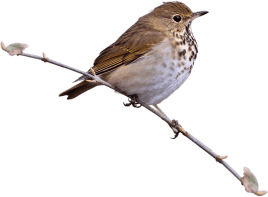Winter Birds in Vermont
5 min read / January 13, 2023
Our website uses cookies to improve your experience. To learn more about how we use cookies, please review our privacy policy.
Can't find what you're looking for? Please contact us.
A creature that weighs about an ounce and can withstand temperatures of -15 (or colder) is a thing of wonder. When a bright day dawns in the heart of a Vermont winter, our winter birds add to the magic of gleaming snow and their darting flights set the stillness alight. Perhaps you’re wondering what you saw at your backyard birdfeeder or out your window? Let us help!
These intense but tiny bundles of energy have very short tails and almost no neck. Red-breasted Nuthatches hop up, down, and sideways on tree trunks and branches, with no regard for which way is up. That’s their way of probing for hidden insects in crevices and under flakes of bark. These songbirds also eat seeds, and the seeds of conifers are especially favored in winter.
Most easily identified by their patterned heads, Red-breasted Nuthatches have a black cap and stripe through the eye that’s broken by a white stripe over the eye. That, together with their excitable, nasal ‘yank-yank’ calls, can confirm you’ve spotted one of these creatures.
This nuthatch prefers dense coniferous forest, but is also at home among oak, maple, and birch trees. It sometimes wanders down toward the ground, often showing little fear of a human standing quietly in a grove.
After Red-breasted Nuthatches excavate nest holes in rotten wood well above the ground, they collect globules of resin from coniferous trees and paste them around the nest entrance, possibly to keep out predators.
They avoid the sticky pitch by diving smartly and directly through the hole!
Listen
An acrobatic forager that can hang upside down, the smallest woodpecker in North America is a familiar sight at backyard feeders, woodlots, and wilderness areas.
The Downy Woodpecker is equally at home on tiny branches and twigs, slender shrubs and weed stalks, and large trees. And, of course, your suet feeder. It generally favors deciduous trees.
In winter the Downy often joins mixed flocks of chickadees, nuthatches, and other birds in the woods. It feeds on a variety of insects, especially beetles and ants, as well as seeds and berries.
Though they do make calls, woodpeckers are better known for their impressive drumming. You may think drumming is part of their feeding habits, but they actually drum to defend territory, attract a mate, or maintain contact with a mate.
To produce the loudest drums, they ram their bills at rapid speeds—up to 25 times per second—into trees. Excavating nests happens slower but requires more force.
Pictured here is a male Downy Woodpecker.
Females lack the red spot at the back of the head. But ‘Downies,’ which are about six-inches tall, can be easily confused with their larger lookalike, the Hairy Woodpecker, which is about nine inches.
Besides size, another clue is the outer tail feathers; they are spotted on a Downy but unmarked on the Hairy.
Downies look so much like the larger Hairy woodpecker, that they ‘look’ like bigger birds to non-woodpeckers and scare them away from feeders and suet.
Listen
You may know the American Goldfinch from its distinctive golden color as it flits through summer meadows. Those bright yellow birds are adult males, while adult females are a duller yellow and olive.
Come winter, both males and females molt, swapping their summer feathers for a brown hue with blackish wings, retaining some yellow on the head.
These small birds in the finch family are active and acrobatic, clinging to weeds and seedheads to pick off seeds, their favorite meal.
They’re quite social, except during nesting season in late summer, and often form a sort of colony of two or three pairs, especially where food and water are plentiful.
Large numbers of Goldfinches sometimes mill about at feeders or on the ground beneath them.
They’re a musical lot, singing ‘per-chick-ory’ or ‘po-ta-to-chip’ during their bouncy, undulating flights. They also eat the small seeds of grasses and of elm, birch, and alder trees, and even buds and bark of young twigs. Some have been known to sip maple sap!
Goldfinches are among the strictest vegetarians in the bird world, selecting an entirely vegetable diet and only inadvertently swallowing an occasional insect.
Listen
One of the ‘winter finches,’ Common Redpolls are tiny, restless birds, seemingly always on the move.
The brown and white birds are emblazoned with a small red forehead patch. Males have a pale red vest on the chest and upper flanks.
Redpolls winter in woodland edges and brushy or weedy fields. They forage in trees, shrubs, weeds, and on the ground, eating mostly seeds and other vegetable matter.
Their diet includes catkins, seeds, and buds of willows, alders, and birches, as well as small conifer seeds.
They often form large flocks, numbering in the hundreds, feeding and then swirling away in a mass of chattering with their distinctive ‘zap’ and ‘dreeee’ calls.
Despite their small size, Common Redpolls have a remarkable ability to survive cold temperatures.
They can store food for up to several hours in a pouch within the throat; this helps the bird in bitterly cold weather because it can feed rapidly and then digest food slowly while resting. In winter, they can eat up to 42 percent of their body mass every day.
During winter, some Common Redpolls tunnel into the snow, sometimes four inches below the surface, to stay warm during the night. And they can survive temperatures of minus 65 Fahrenheit.
Listen
Once described as a “sparrow dipped in raspberry juice,” the Purple Finch bears a misnomer because the color of the males (pictured) is an elegant old-rose. Females are a streaked brown, but their striking patterning makes up for a lack of vivid color.
In winter, Purple Finches can be found in a variety of habitats, including shrublands, old fields, forest edges, and backyards.
Their winter diet consists mainly of seeds, including those of trees such as ash and elm, as well as weed and grass seeds. They also eat buds of many trees, as well as berries and small fruit. With large, conical, powerful beaks, they seem to like black oil sunflower seeds best.
While their own song is a rich musical warble, Purple Finches sometimes ‘borrow’ the sounds of other species, including Barn Swallows, American Goldfinches, and Eastern Towhees.
These finches have become less numerous as feeder visitors in the Northeast, losing out to House Finches that were introduced in the 1950s. A study of finch behavior found that Purple Finches lost out to House Finches more than 95% of the times the two birds encountered each other.
Like many birders and researchers, for a long time VLT forester Pieter van Loon thought that only male birds sing. One day he heard a song, looked through his binoculars and was amazed: it was a female Purple Finch (pictured left). He learned that many female birds sing; there’s a website devoted to gathering female birdsong. Anyone can participate in the citizen science project.
ListenThis crested little bird with a startled expression is common in our forests and at our feeders, where its delightful whistle of peter-peter-peter may be heard even during mid-winter thaws.
The Tufted Titmouse mostly inhabits deciduous forest with tall trees and sometimes mixed forest, but they can also live in orchards or suburban areas, if the trees are large enough.
Titmice flit from branch to branch, hang upside down or sideways to explore cones, twig-ends, and leaf clusters, and even hover momentarily while looking for food. You may see them foraging in the company of nuthatches, chickadees (their relation), and woodpeckers.
When they find large seeds, such as the sunflower seeds they take from bird feeders, titmice typically carry their prize to a perch, then hold the seed with their feet and hammer it open with their stout beaks.
Seeds, nuts, berries, and small fruits are especially important for Tufted Titmice in winter. Carrying a single seed at a time, they hoard seeds in bark crevices during fall and winter. In summer, they eat mainly insects, including caterpillars and stink bugs.
Tufted Titmice nest in natural holes and cavities left by woodpeckers (and nest boxes), because they can’t excavate their own nest cavities.
Their dependence on dead wood for their homes is one reason why it’s important to allow dead trees to remain in forests.
Listen
The Evening Grosbeak is one of the few birds that flies from its northern and western breeding grounds to winter in Vermont. It brings a splash of color when it arrives in noisy flocks, often showing up at platform feeders offering sunflower seeds.
The males are yellow-bodied and dusky-headed with a massive bill and fierce eyebrow stripe. Females (pictured) have more subtle coloring, with gold highlights on gray plumage. Out in the woods, you’ll have better luck finding a flock if you listen for their running patter of call notes, which can be sweet, burry, or sharp.
Social birds that are often found in flocks, particularly in winter, Evening Grosbeaks also seek out the seeds, berries, and buds of trees and shrubs—especially maples. They sip oozing maple sap by breaking off small maple twigs.
At feeders, you’ll often see them with Common Redpolls and Pine Siskins because, with their enormous bills, Evening Grosbeaks can crush seeds that are too large for those smaller birds to open. These smaller birds glean the food scraps that are left behind.
While they’re adept seed-crackers in the wintertime, in summer Evening Grosbeaks eat insects such as the spruce budworm, a serious forest pest. They’re so skilled at finding these tiny caterpillars that the presence of the birds can provide a warning sign of a budworm outbreak.
Pictured: a male Evening Grosbeak
Listen
Photos by Pieter van Loon, VLT forester, except Evening Grosbeak, by
VLT Project Director, Bob Heiser.





We generally send two emails per month. You can unsubscribe at any time.